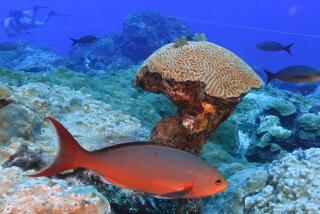A little conservation goes a long way in Australia’s Great Barrier Reef
- Share via
Experts have reported some good news about their long-running efforts to protect fish in Australia’s Great Barrier Reef: A ban on fishing in one large portion of the reef has helped fish throughout the habitat.
The protections also appear to have aided the area’s recovery after Tropical Cyclone Hamish, a particularly destructive storm that struck the Great Barrier Reef and Queensland in 2009.
The Great Barrier Reef, which spans more than 1,400 miles along the northeastern coast of Australia, is the largest and one of the most ecologically diverse coral reefs in the world. The UNESCO World Heritage site is home to thousands of aquatic species, including 1,500 kinds of fish, the threatened sea cow, and six species of vulnerable or endangered sea turtles.
But oil and gas mining, coastal development and commercial fishing all put the coral reef at risk. So the Australian government established the Great Barrier Reef Marine Park in 1975 to protect and preserve the area for future generations.
Still, problems continued to plague the reef. In the last 30 years, the Great Barrier Reef has lost half its coral cover.
Throughout the 1980s, large tracts of reef were decimated by a wave of crown-of-thorns starfish, which in high enough numbers eat up the coral faster than it can regrow. Meanwhile, fishermen upped their annual catch from 201 tons in 1980 to 1,490 tons in 1990. And in the last decade, a series of enormous cyclones battered the reef.
But there’s a glimmer of hope. In 2004, the Great Barrier Reef Marine Park Authority and the Australian government expanded the “no-take” zones in the Great Barrier Reef Marine Park from 5% of the total territory to one-third. The expansion has been a boon to the coral trout, the most commercially important species in the area.
It may seem obvious that a prohibition against fishing would be good for the fish, but that’s not always the case. One concern with expanding no-take zones is that it simply pushes fisherman in to other unprotected areas – what scientists call the “squeeze effect.”
That’s why the researchers were pleasantly surprised to find that after almost a decade of protection, the coral trout population had stabilized, said Michael Emslie of the Australian Institute of Marine Science in Townsville, Queensland. Indeed, the fish in the protected area were larger and more numerous than their counterparts in other areas of the reef where fishing is permitted.
“It was particularly gratifying to see that fish numbers had rebounded to historical levels,” said Emslie, the lead author of a report about the policy’s effects, published recently in the journal Current Biology. “It shows that controversial action such as this can take positive steps towards conserving the Great Barrier Reef and safeguarding it for generations to come.”
Emslie and his colleagues examined 30 years of underwater survey data on fish numbers and sizes in areas open and closed to fishing.
In the “no-take marine reserve” areas, or green zones, between 53% and 67% of the fish were larger than the legal catch size of 15 inches. That translated to 82% to 89% more biomass in protected zones compared to reefs where fishing was allowed.
The study suggests the expansion of no-take reserves combined with effective fishery management actions – such as a fishing license buyout program – have lowered the overall catch to what appears to be sustainable levels, Emslie said.
And lessons learned in Queensland could spread to other parts of the world. The Great Barrier Reef, the study notes, is a model for other marine reserves and has inspired similar measures on the West Coast of the United States, Hawaii and the Mediterranean.
While fishing restrictions can’t directly protect a coral reef from a natural event, such as, say, a cyclone, maintaining pockets of healthy fish populations could aid and speed an area’s recovery later on.
In 2009, Tropical Cyclone Hamish hit the Great Barrier Reef, several damaging coral cover and the coral trout density, or the number of fish per unit area, in both fished and protected reefs. But the biomass, the total weight, of coral trout fell only in the fished reefs, Emslie said. This suggests that larger fish may be able to withstand the turbulence of a cyclone or are better suited to relocate to deeper, undamaged habitat.
The large and healthy individuals in the green zones should be able to “reseed” the damaged areas, he said.
But the reef faces many threats that no-take reserves can’t protect against, including pollution, coastal development and climate change, the scientists warned in their study.
“Ensuring the continuation of the reef as we know it will require global and regional action beyond what local marine parks can achieve,” Emslie said.
Follow me on Twitter @seangreene89 and “like” Los Angeles Times Science & Health on Facebook.







